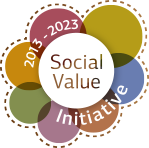Project Description
1 kWh of windpower
The pilots were intended to test the methodology proposed in the handbook during the 3rd phase of the Roundtable for Product Social Metrics.
Introduction
The subject of the study was 1 kWh of electricity generated by Vattenfall’s Nordic wind farms in Denmark and Sweden. The study focused on the core processes of the value chain, namely the development, construction and operation of wind farms. Distribution of electricity was judged to be less important as we expected the largest impact to be on local communities regarding the operation and on workers in the supply chain.
The goal of the study was to measure social impacts of the generation of electricity on local communities, society and workers. Another aim was to elaborate on Product Social Impact Assessment and find ways to integrate it with product declaration in accordance with the International EPD® System. The objective was to move towards an integrated approach and to see how product social impact assessment could be a part of product declaration.
Application of the Methodology
For this pilot, the quantitative approach was chosen primarily to facilitate further building on work previously undertaken within the organisation. Topics were selected following internal discussions as well as being based on an earlier company materiality analysis on wind power. In addition to selecting indicators from this handbook, the UNEP SETAC Guidelines for Social LCA of Products, and the Global Reporting Initiative (GRI), internal company indicators were used, since these corresponded more closely to the materiality analysis that had already been done and increased opportunities to find data for the indicators included in the study.
Operationalisation and feasibility
The assessment was carried out by employees within the environmental department, supported by a human rights expert from the sustainability department. The assessment was conducted with the support of various internal departments: procurement, human resources, health and safety, professional training and the Wind Business Area. The external parties involved in the assessment were one turbine supplier and a service contractor.
Data collection methods included internal interviews, extraction of data from internal systems, and questionnaires sent to four first-tier suppliers (of which two replied), in addition to using generic data provided by Verisk Maplecroft for the supply chain. The data collection from suppliers was supported by phone calls to explain the topic, followed by an interview for open discussion. Hard data was provided in the questionnaires completed after the interviews.
Weighting of supply chain impact on different manufacturing processes was applied to mass data as this was the only information available.
The interviews were received very positively by the first-tier suppliers but it was not always possible to find the data that was requested. Another issue experienced was that it was even more difficult to find generic data from external sources that corresponded to the indicators, making it difficult to include the full life cycle of the product. Better sources of generic data are needed.
Value added
The results of the assessment were considered useful mainly for customer communication and stakeholder dialogues, as part of the environmental product declaration for electricity. Developing the method further, so that it becomes easier to apply, will also improve opportunities to use it for driving and monitoring improvements throughout the whole value chain. It may also be a tool to enhance collaboration on crucial sustainability issues with key suppliers. The handbook helps make the area of social impact assessments for businesses more concrete.


